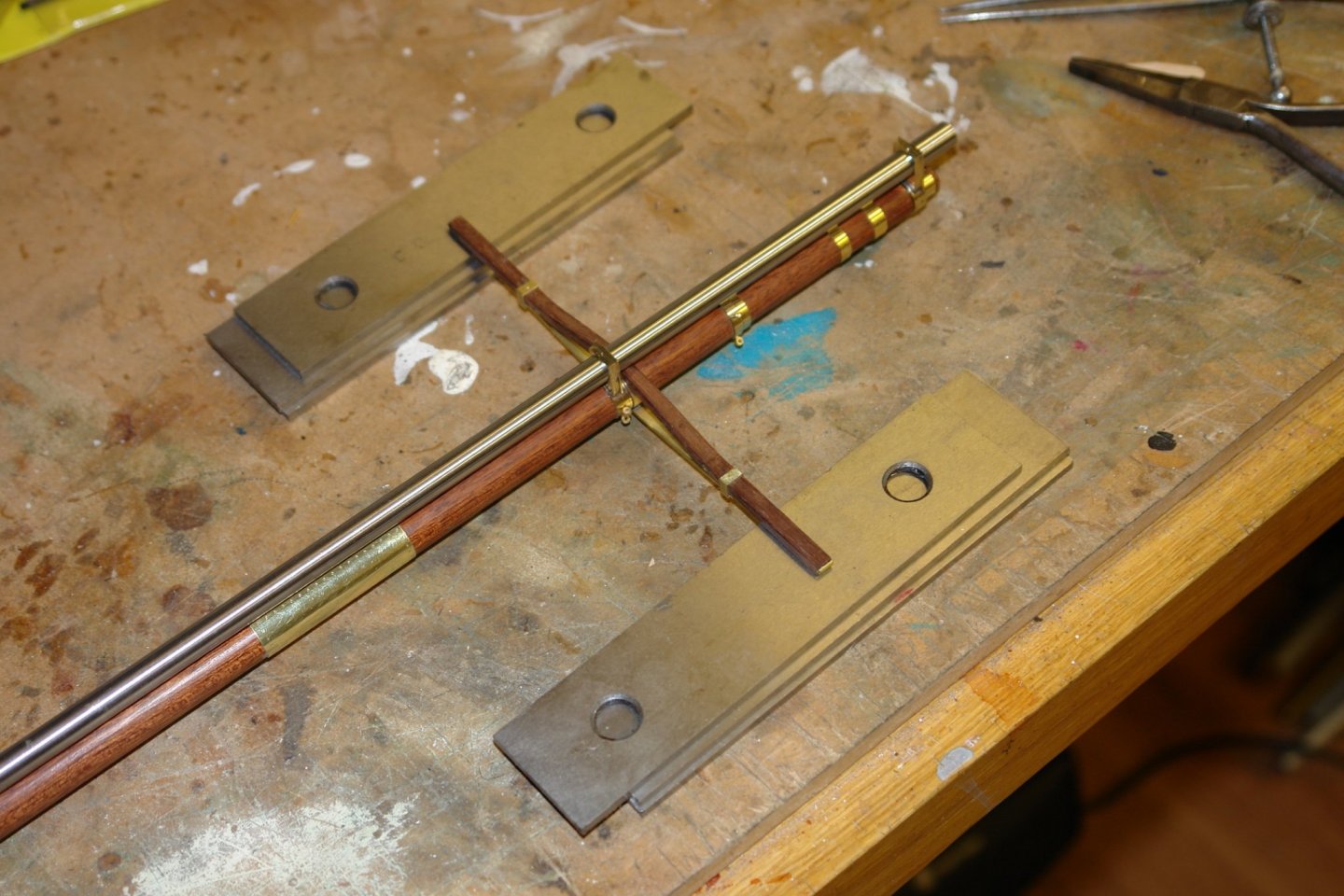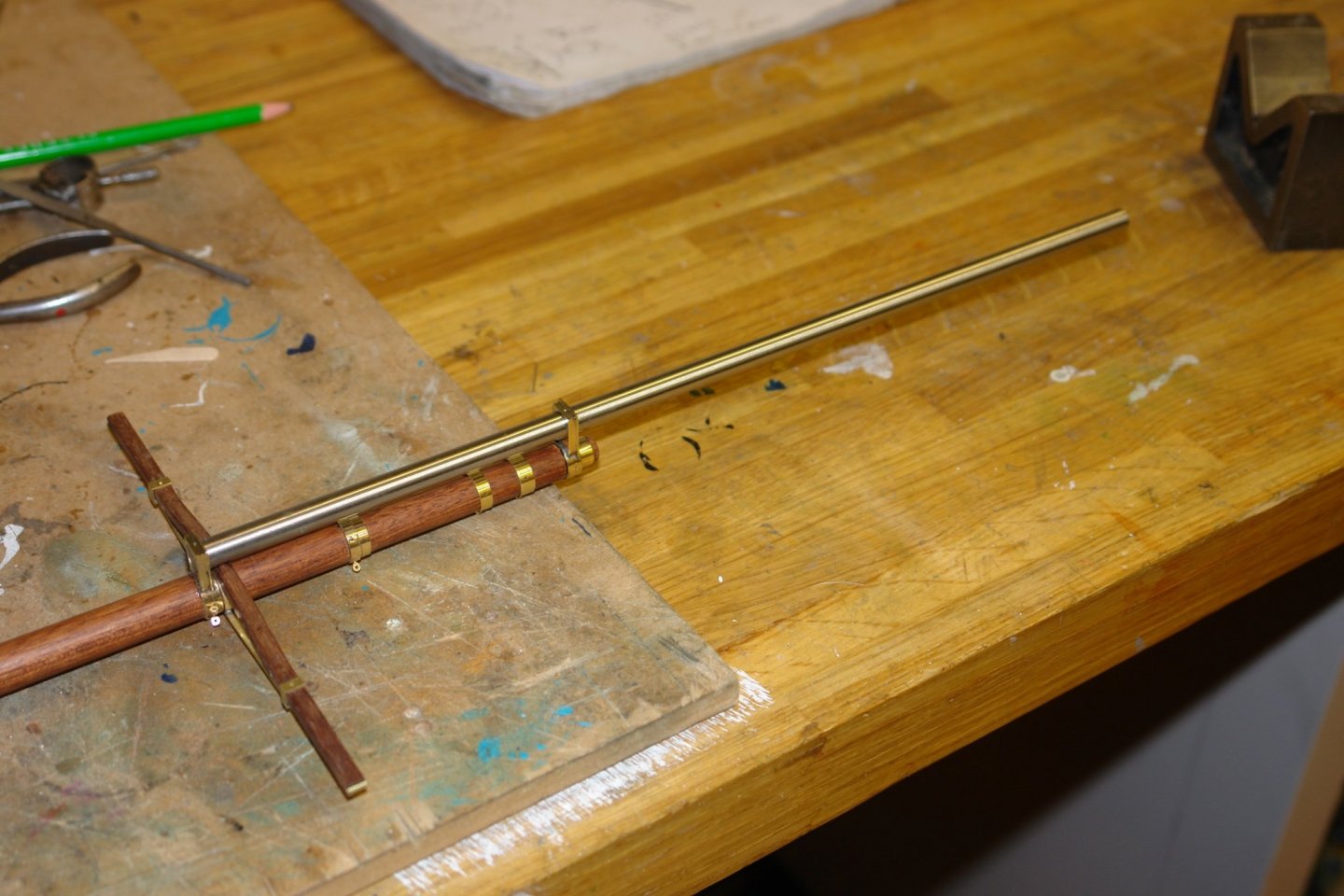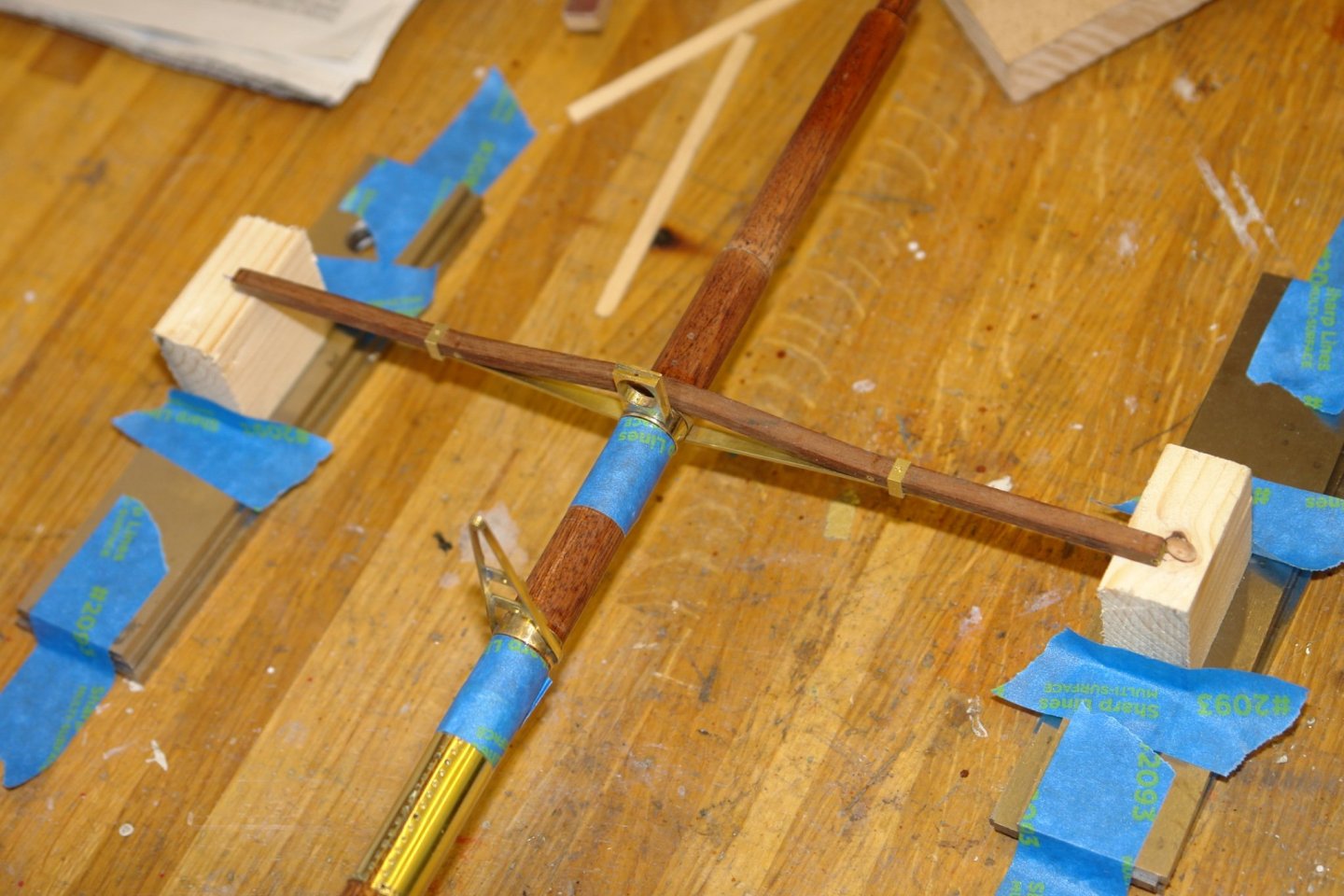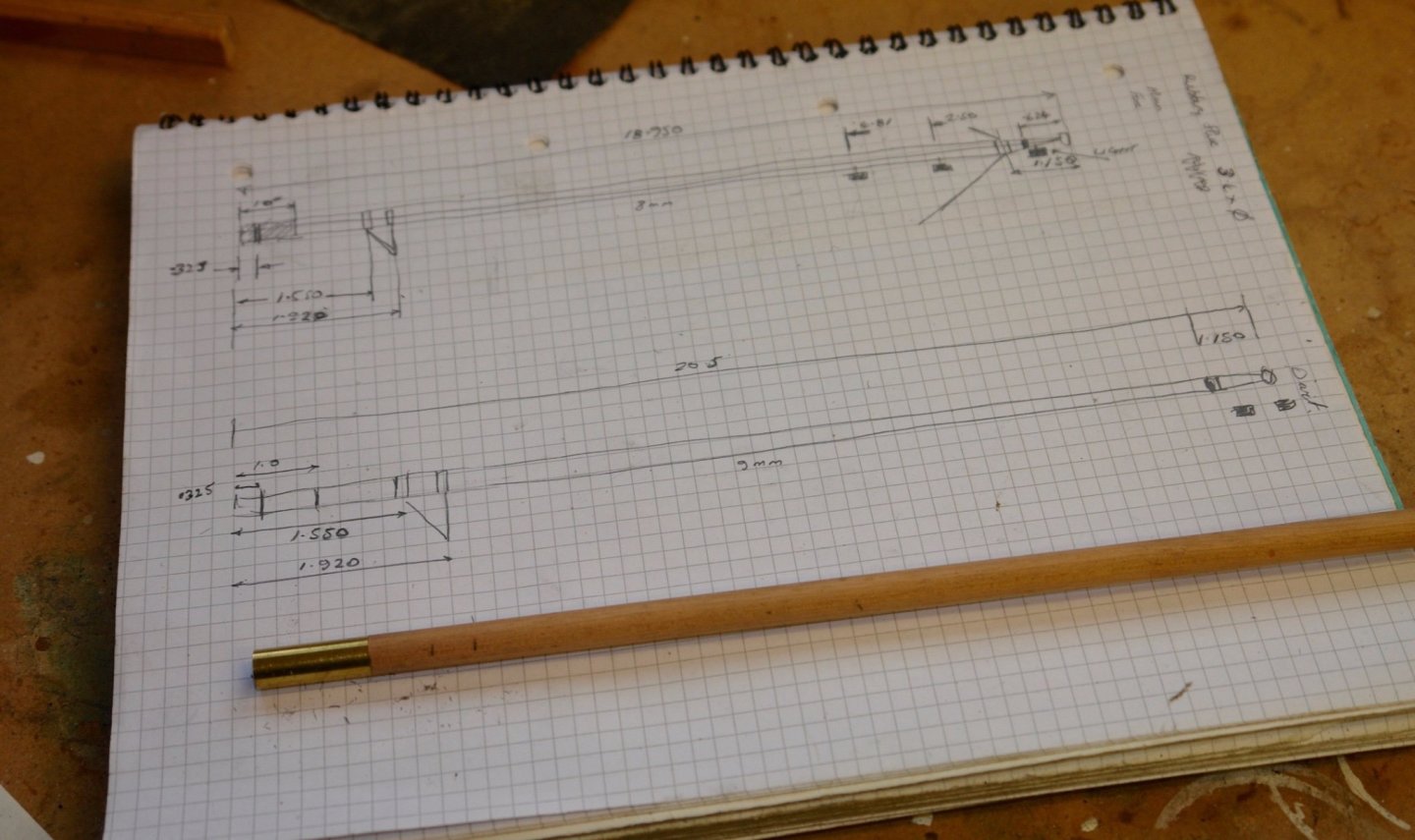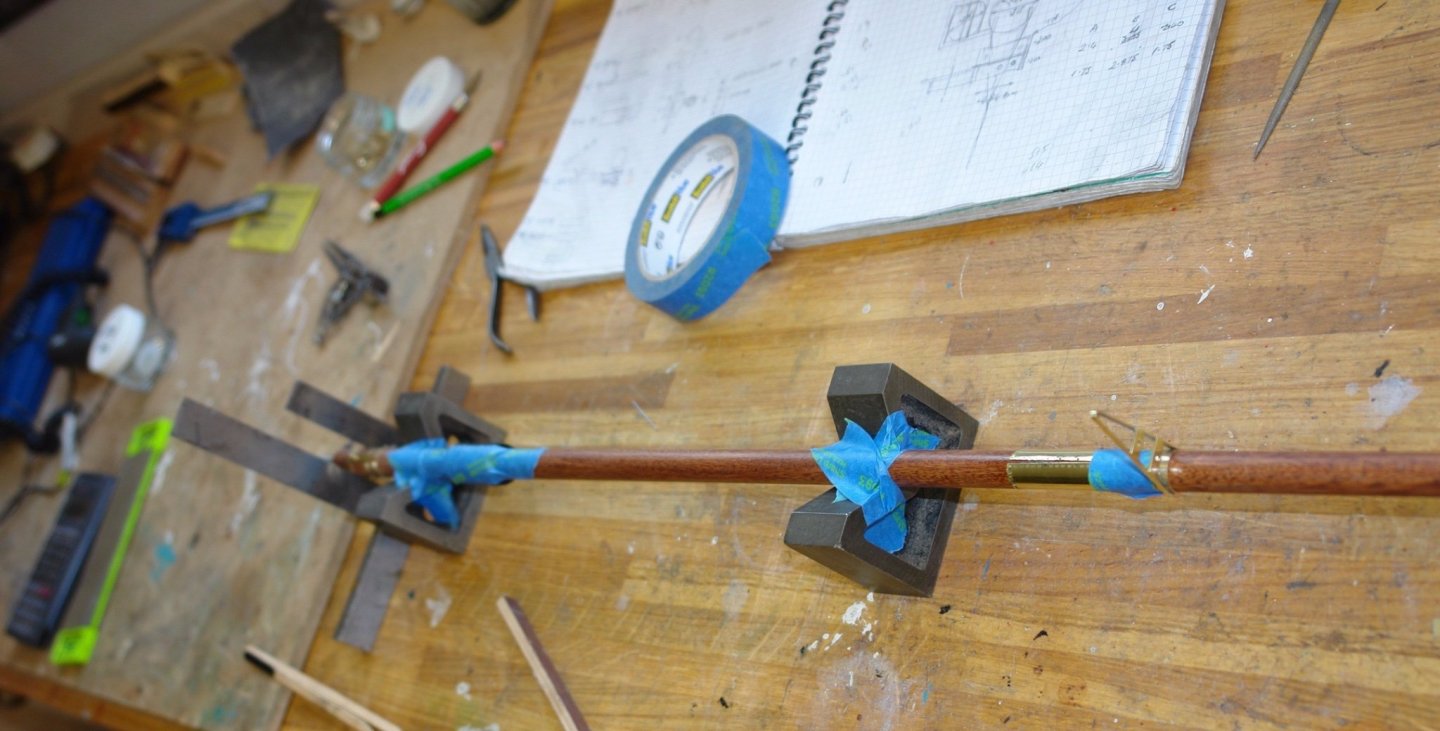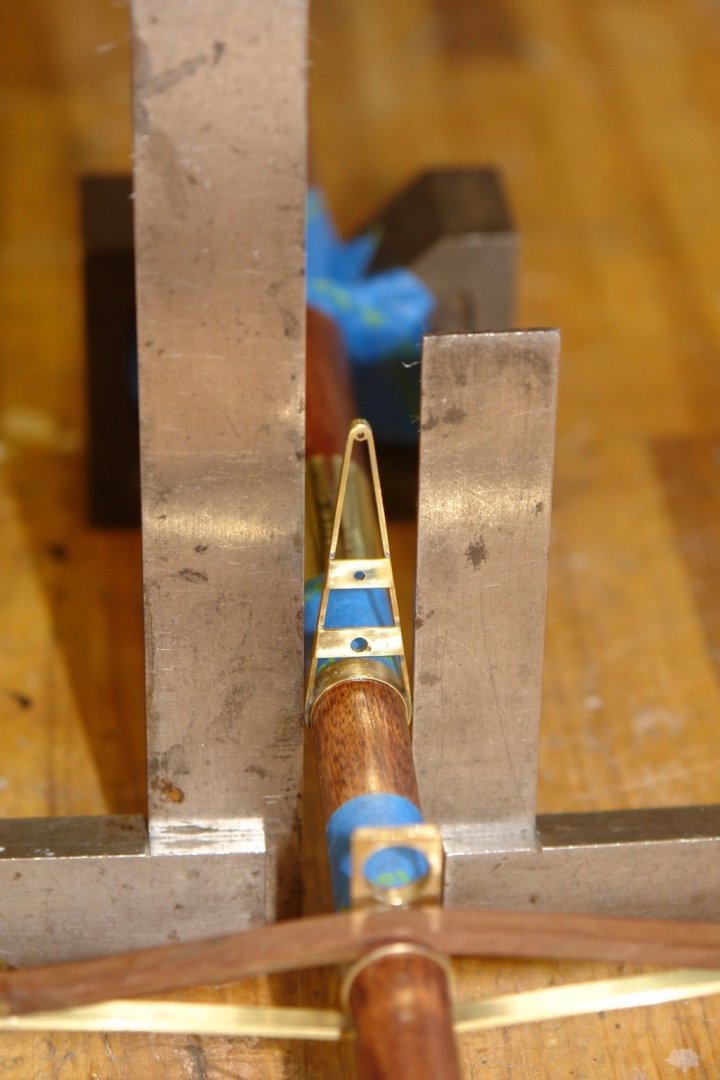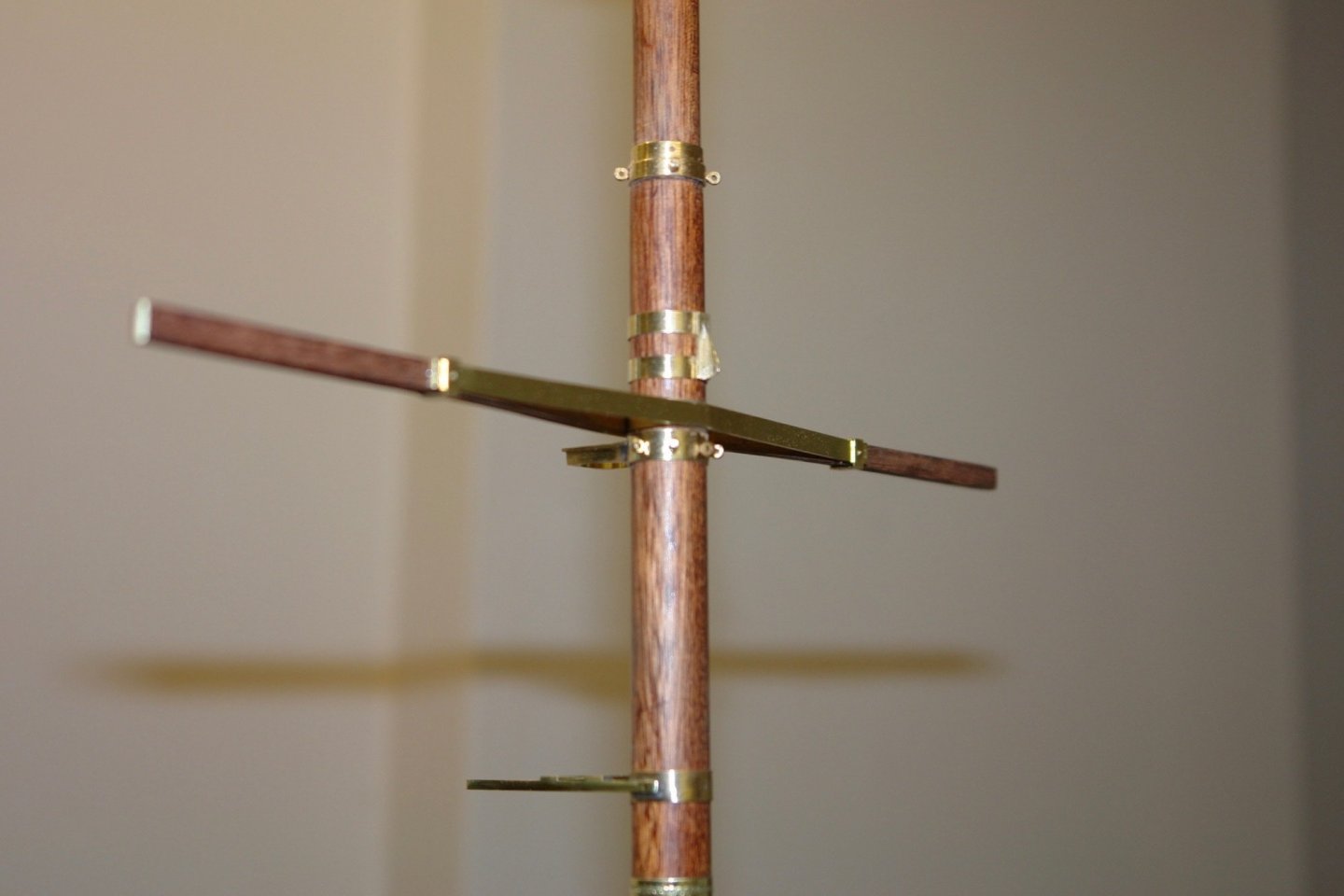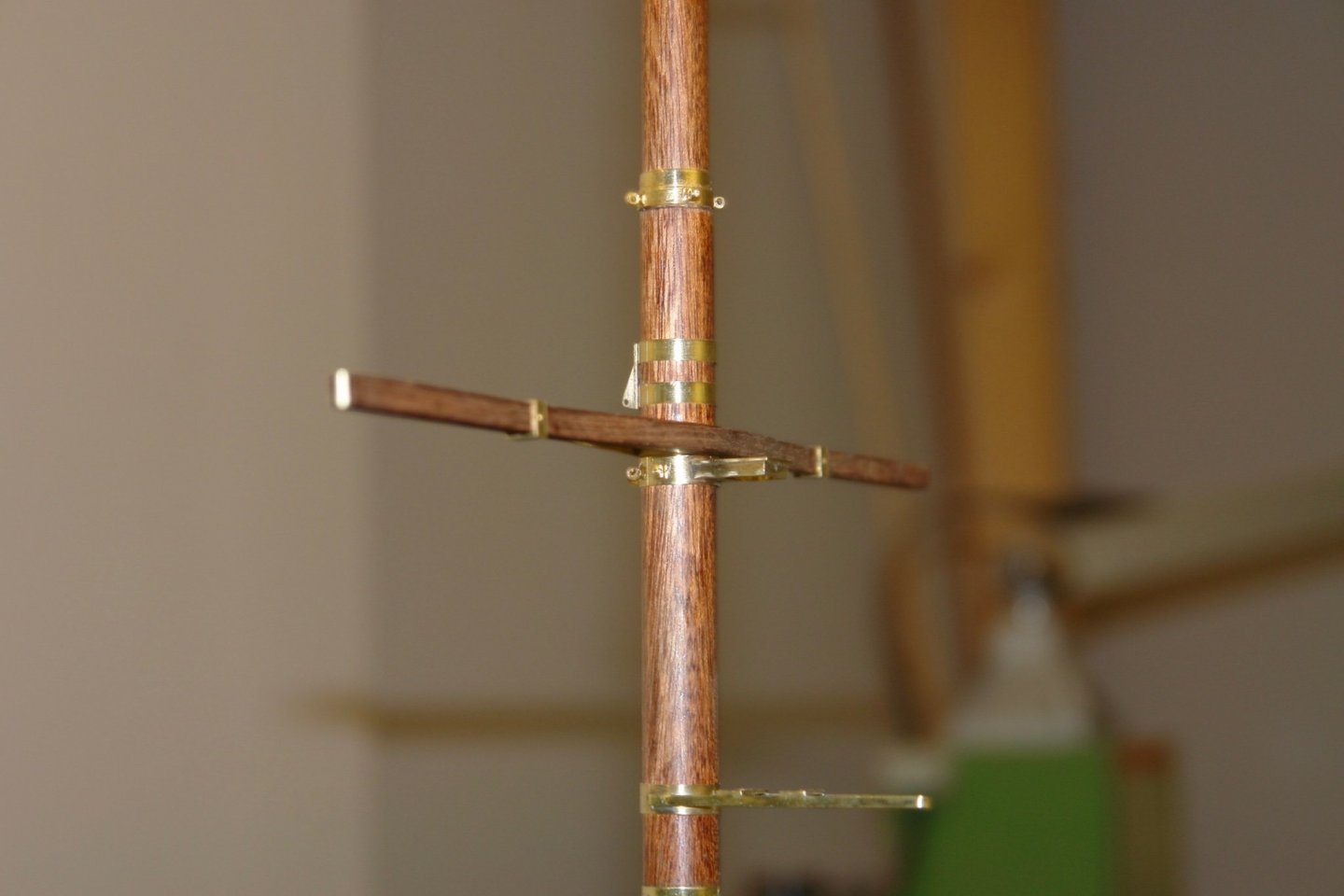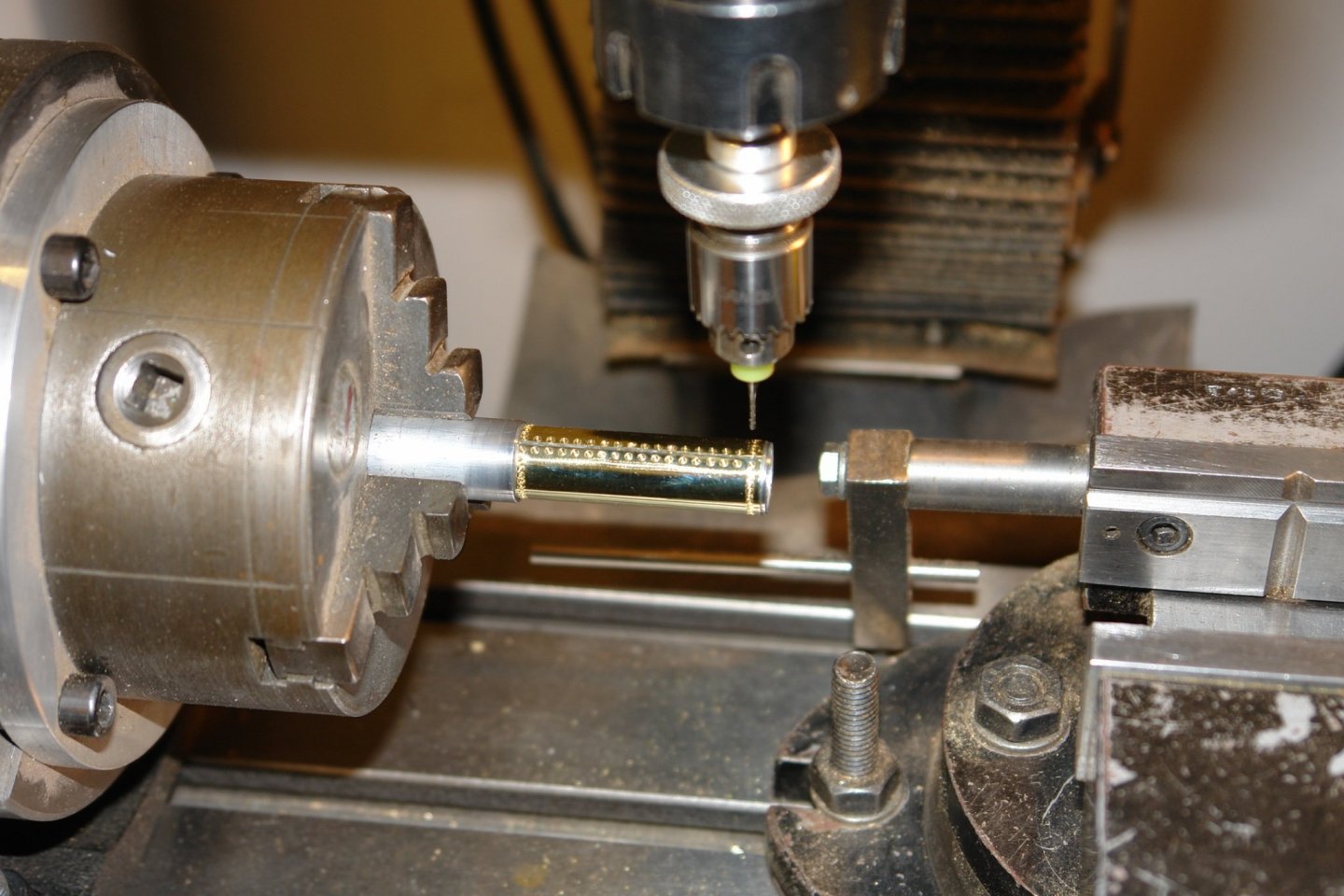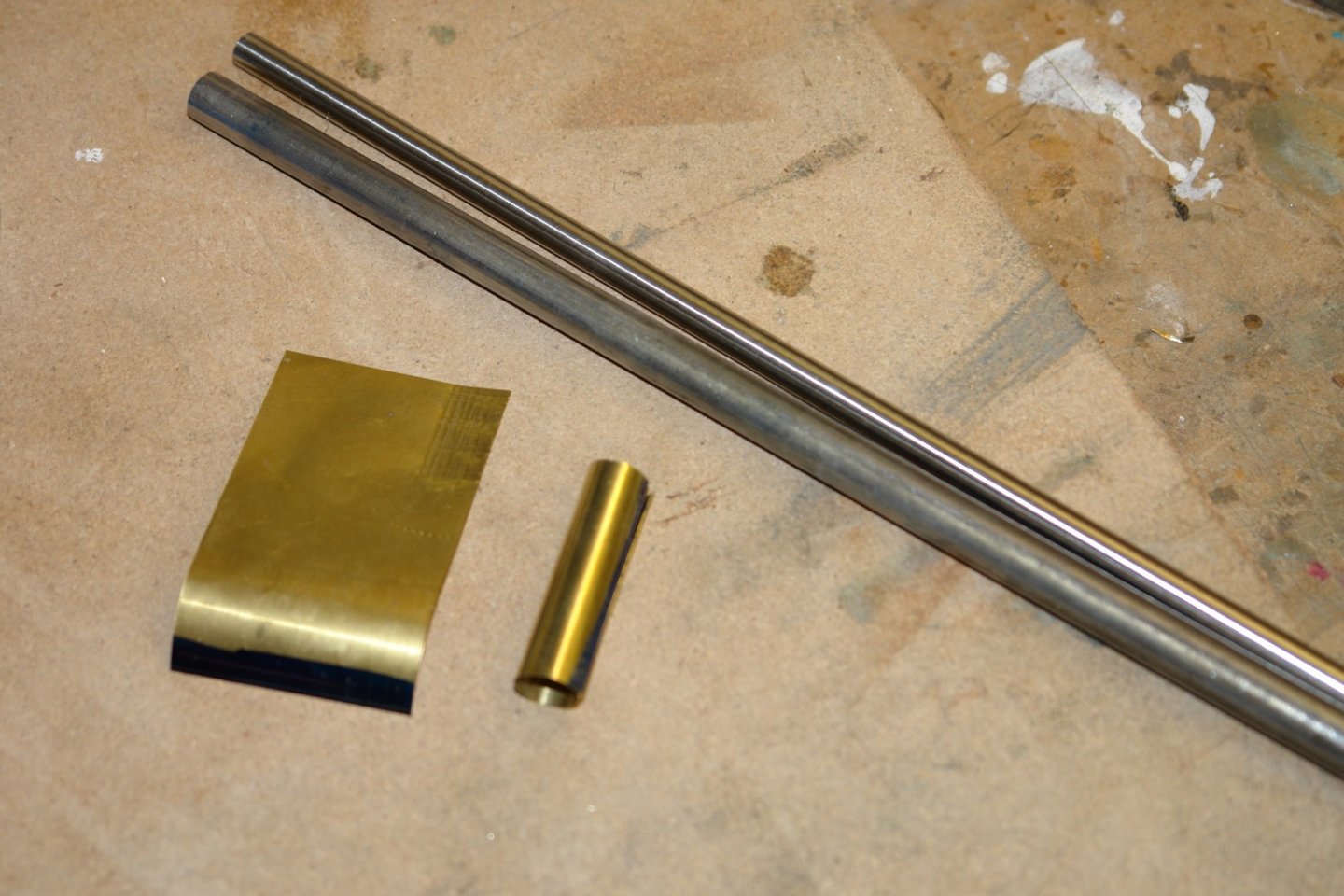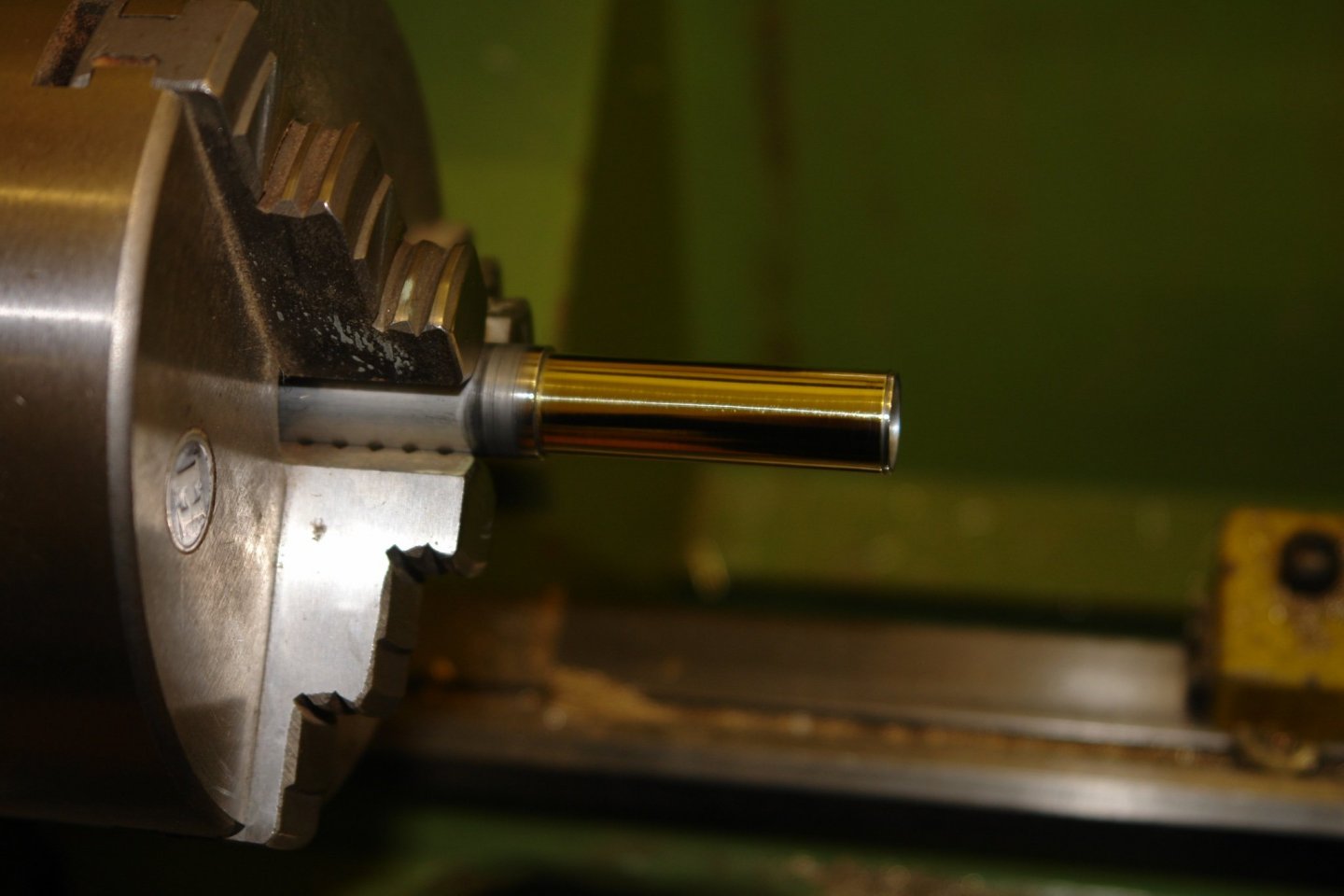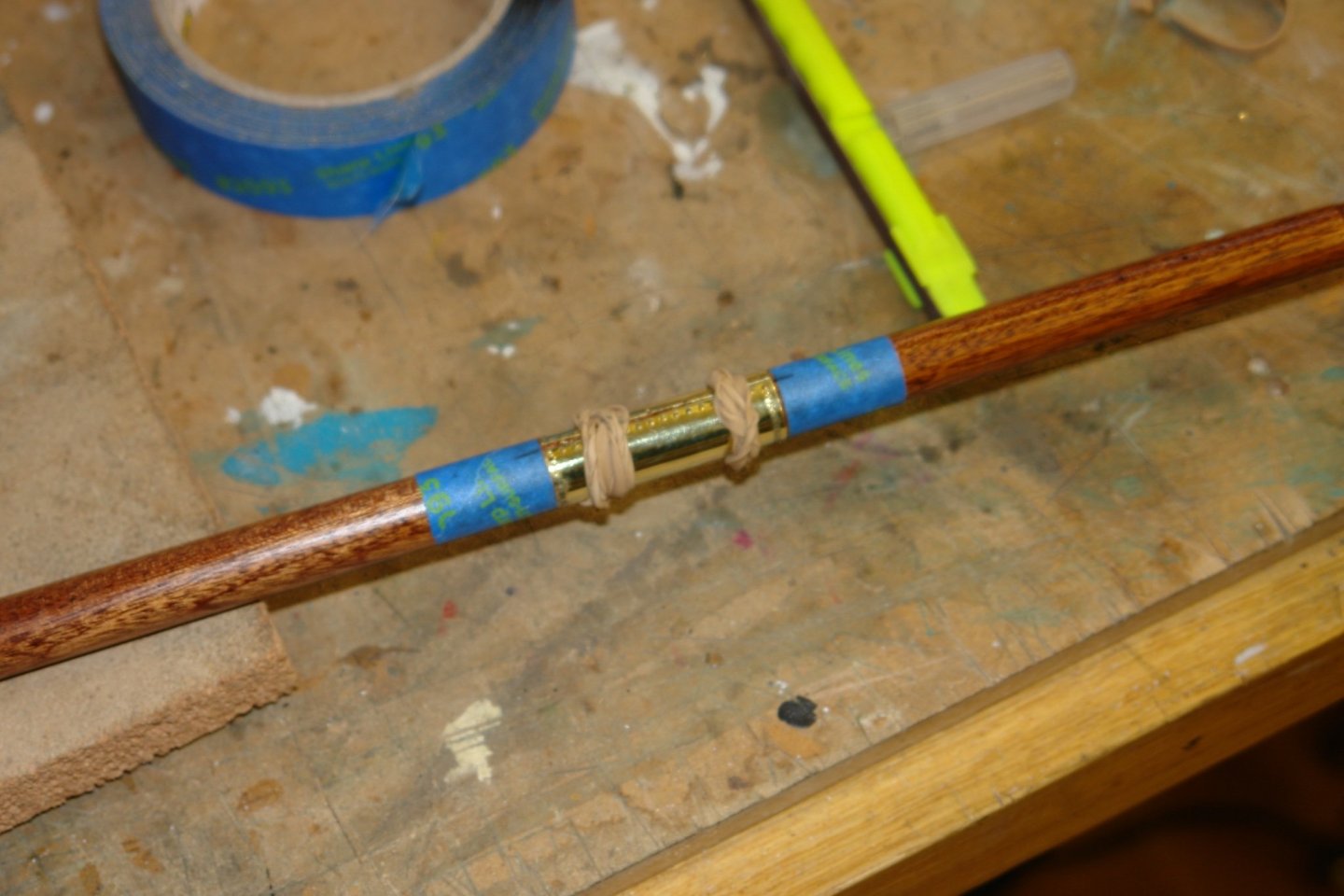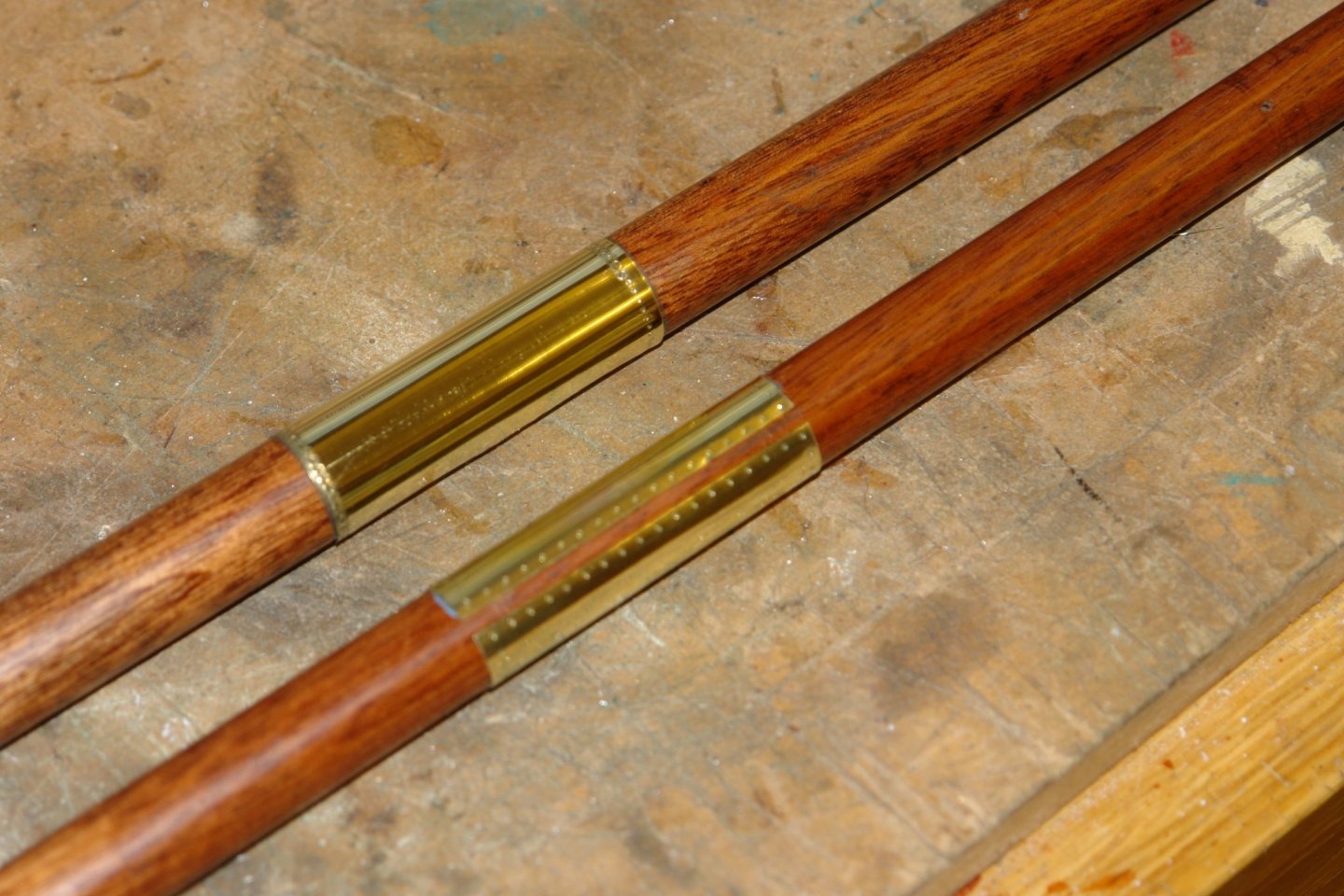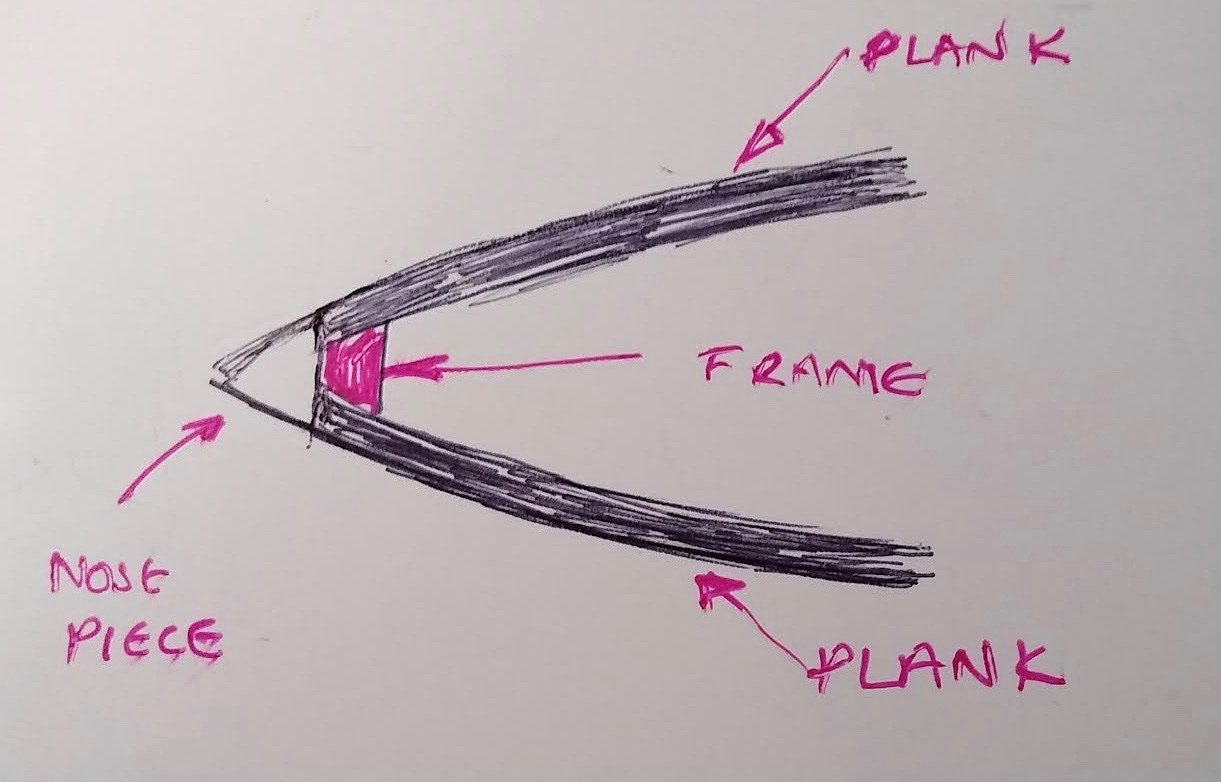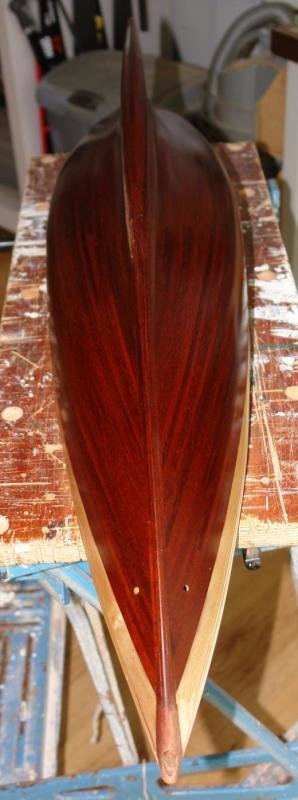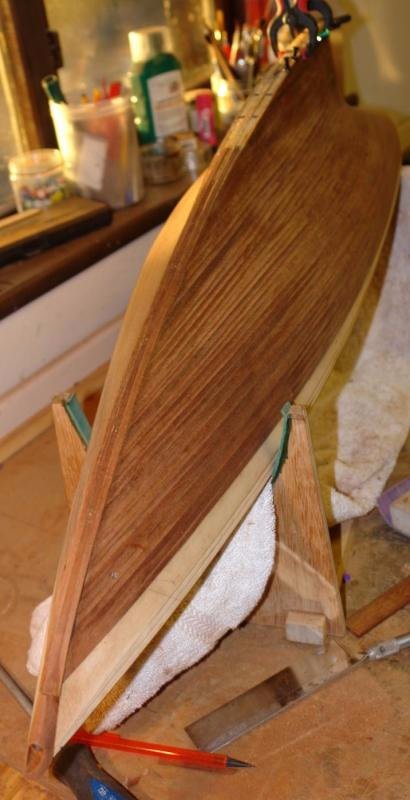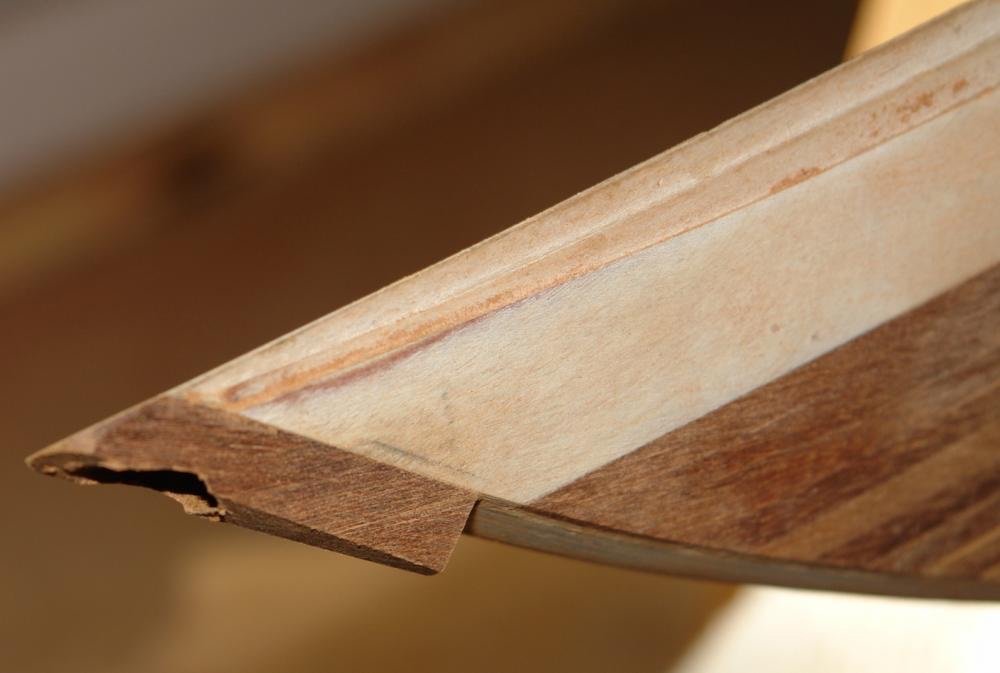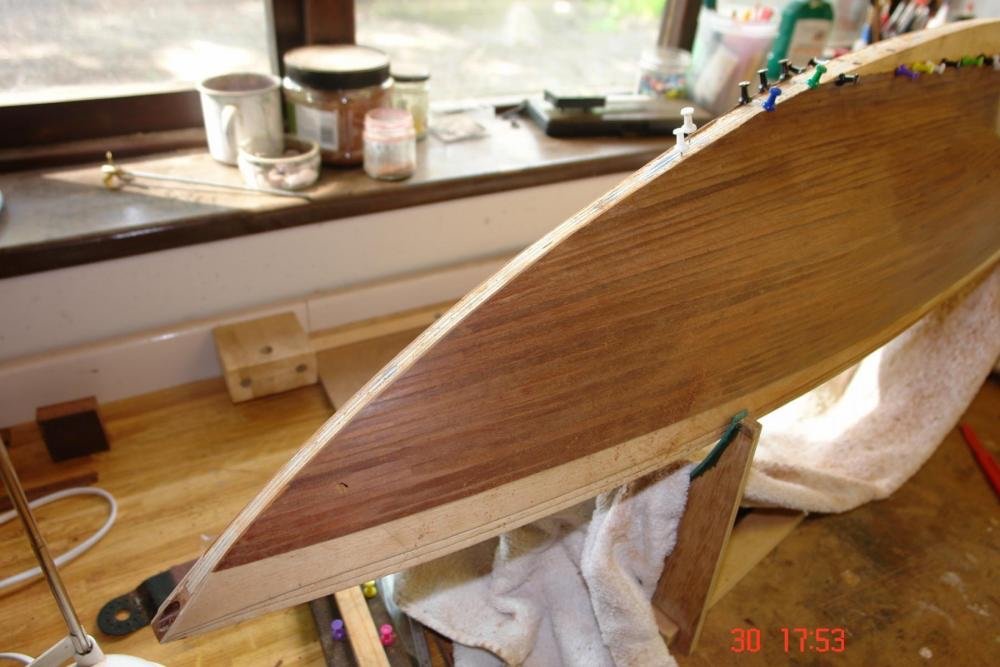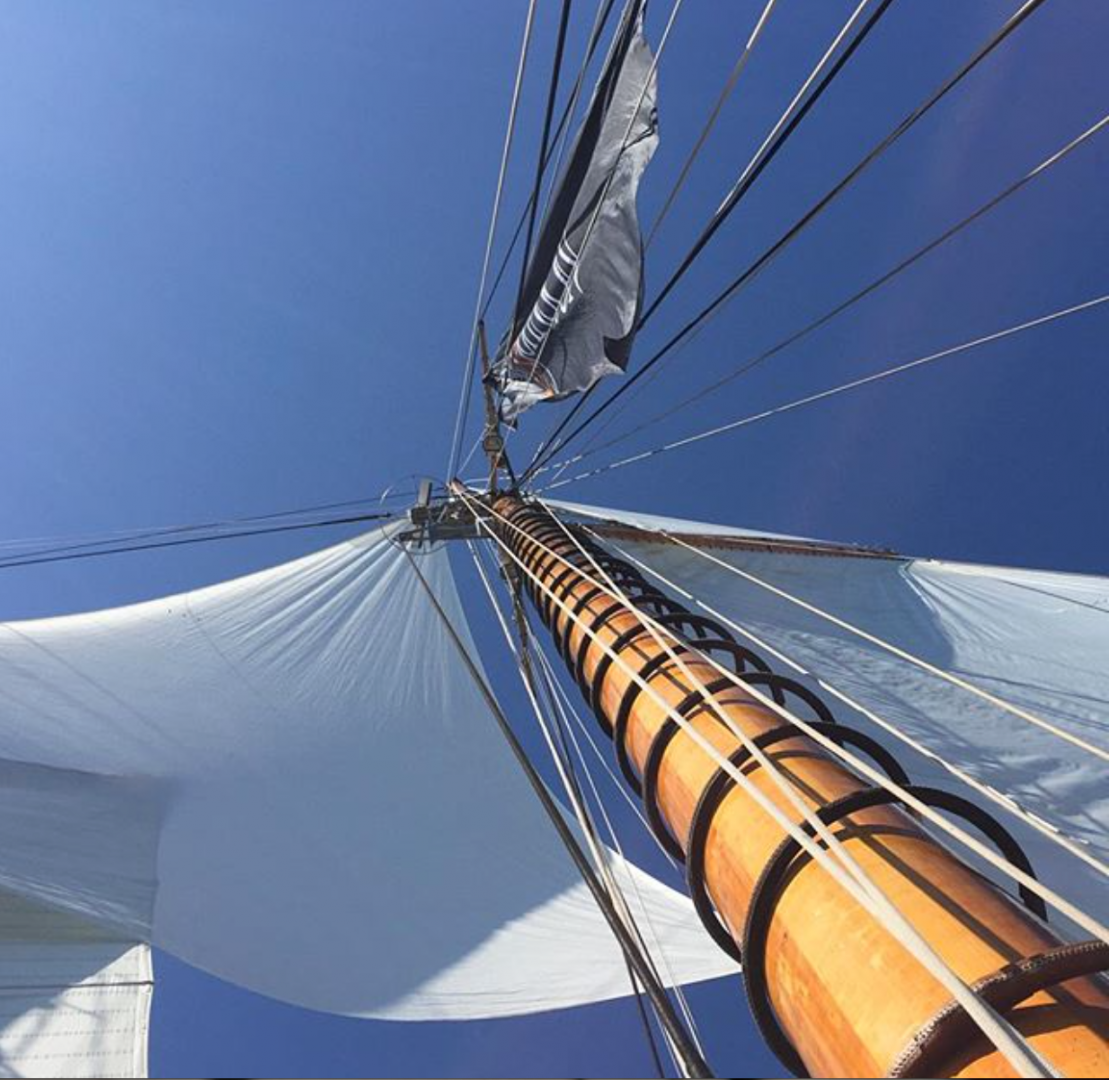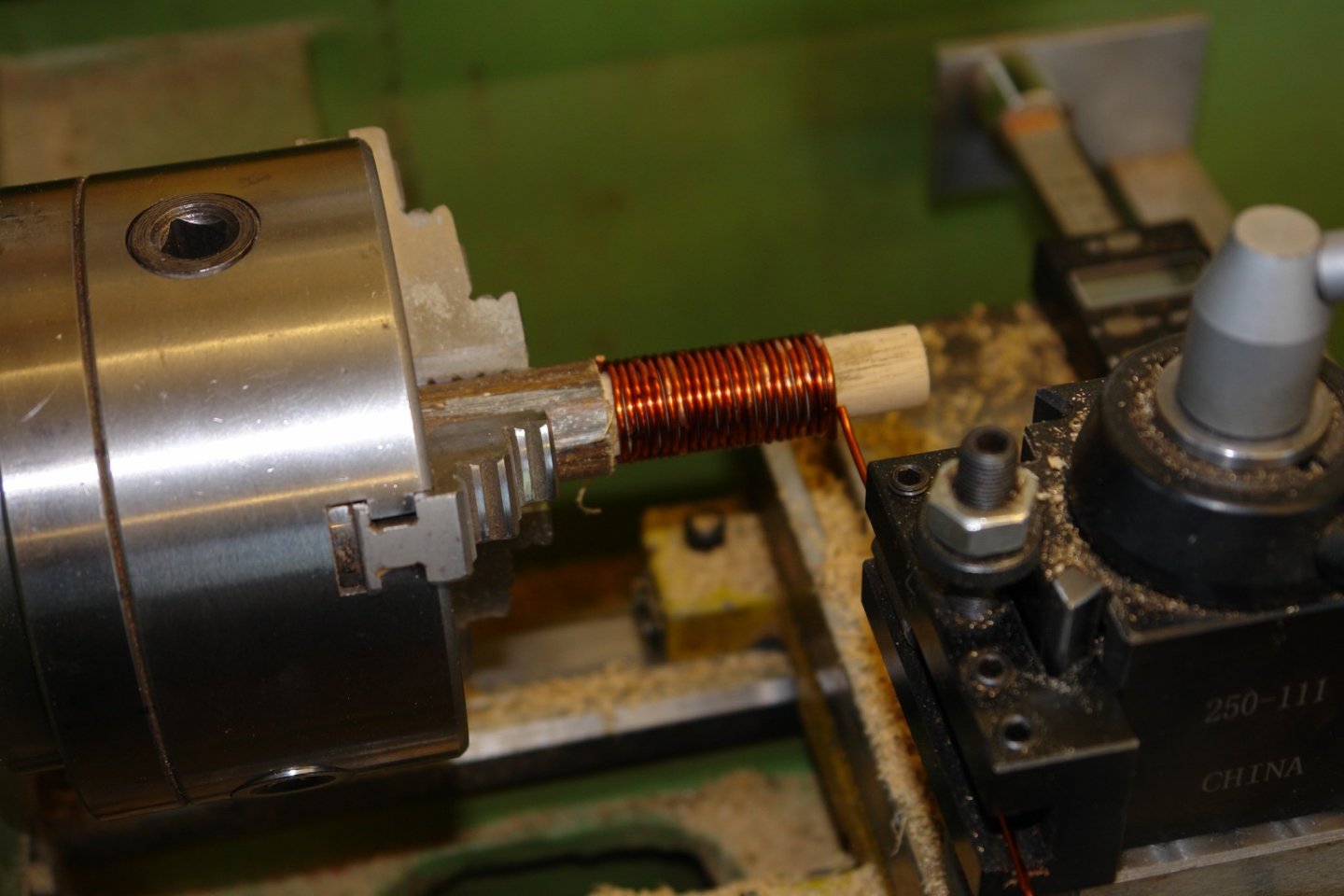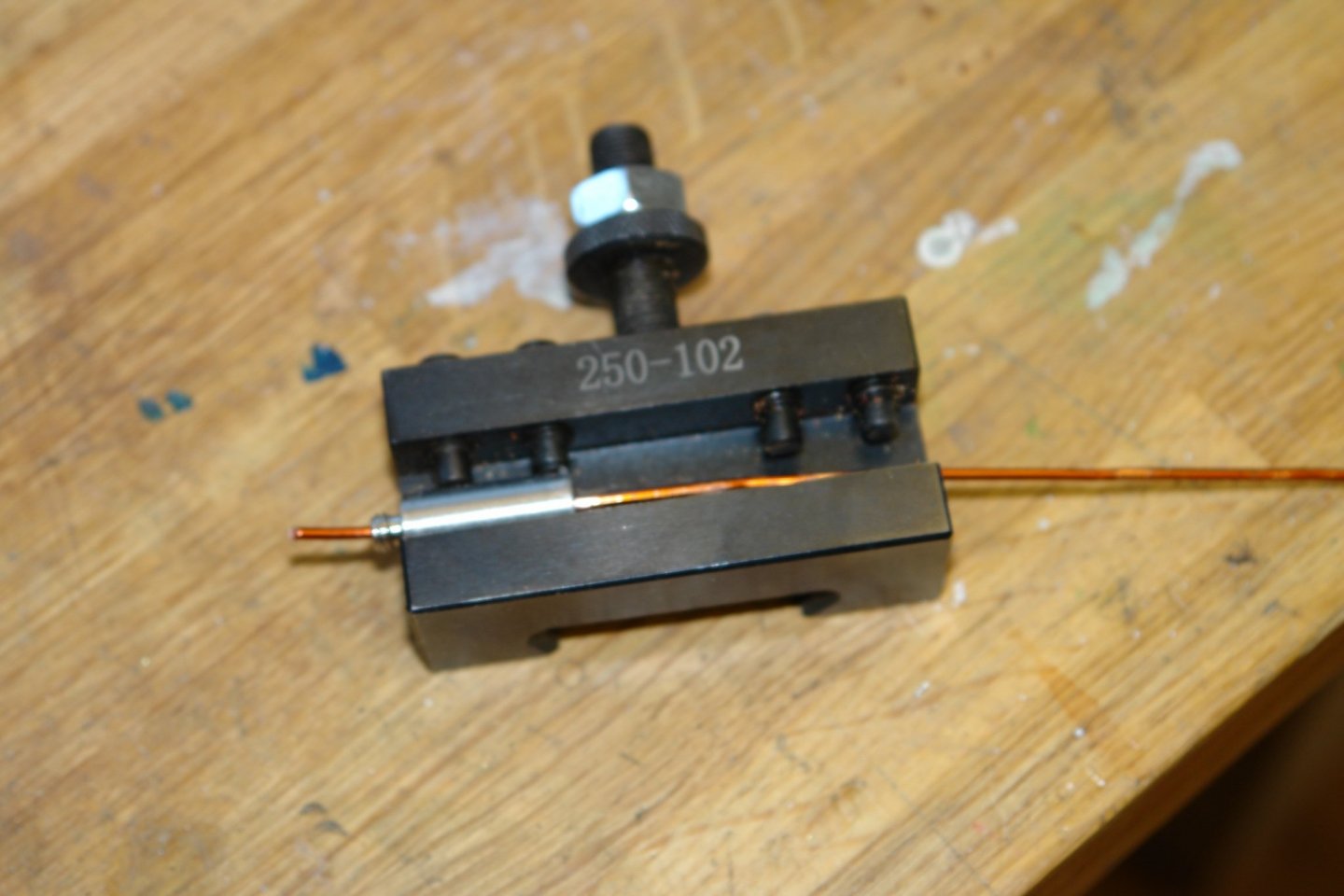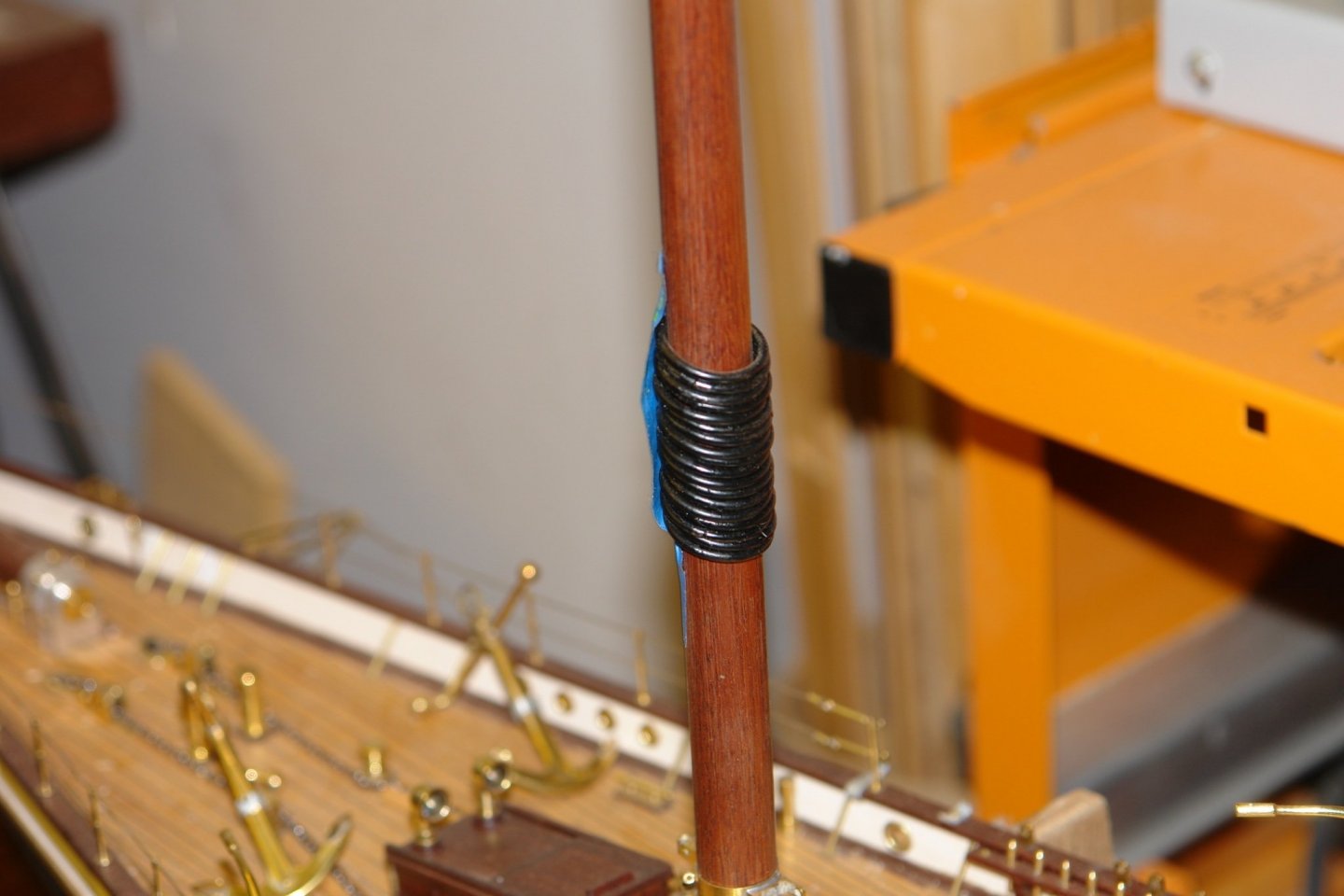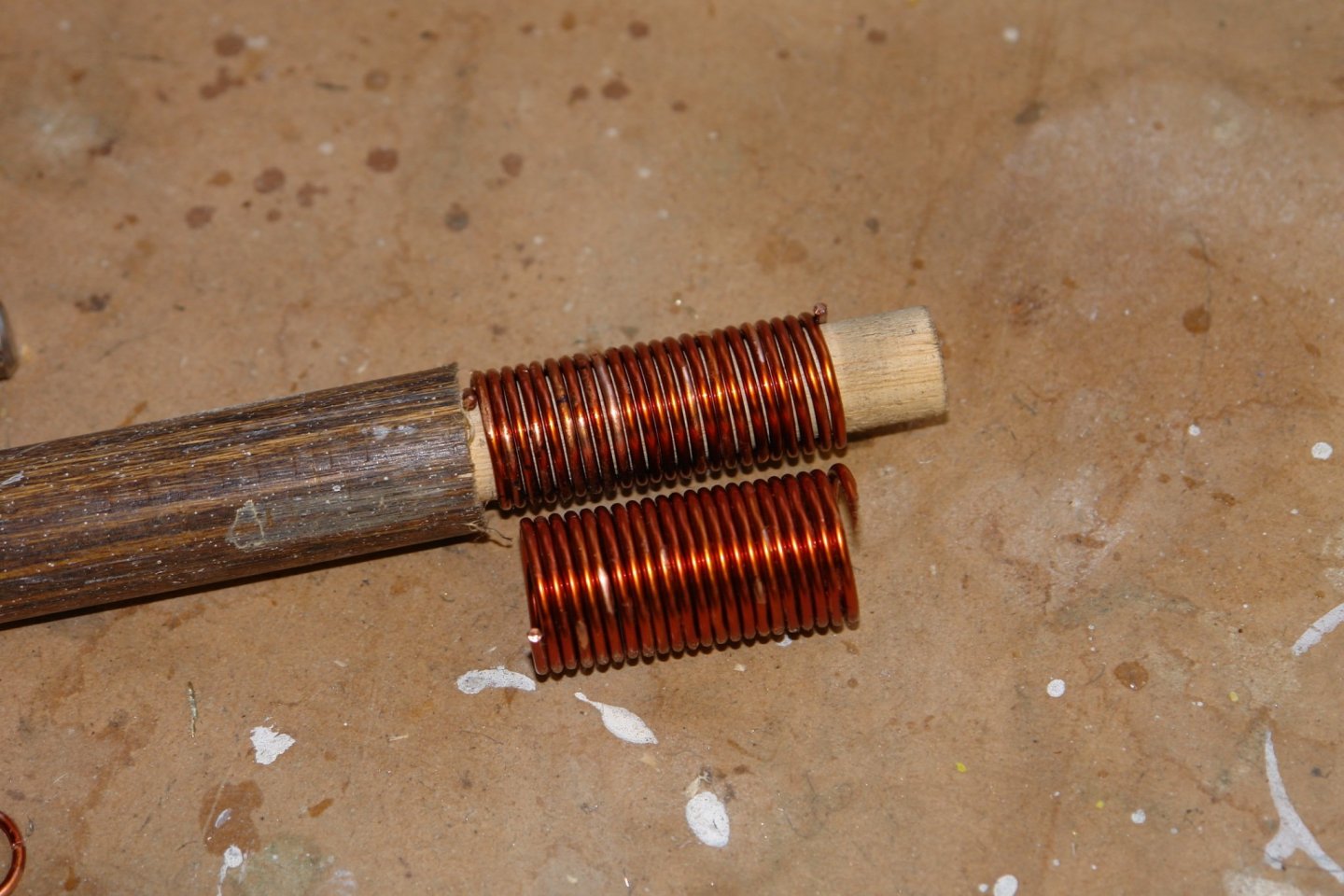-
Posts
3,944 -
Joined
-
Last visited
Content Type
Profiles
Forums
Gallery
Events
Everything posted by KeithAug
-
I am still working on the main and fore masts. A lot of the last few days has gone into set up and axial alignment of the lower and upper masts. I started by glueing and pinning the cross trees to the lower masts. With the cross trees correctly positioned I used them supported on shims (milling parallels) to set the lower mast off the bench. With this set up I used a steel rod to align and fix the rotational positions of the upper mast support brackets. These brackets were then glued and pinned. I then made the upper masts with their various hoops. Both upper masts are similar differing slightly in lengths and diameters. They taper at the upper end and have a parallel section that slides in the brackets. The photo below shows the sizes and one of the upper masts in preparation. Drilling cross holes in the masts at right angles can be a bit tricky and my short cut for doing this is to clamp a collet block to the mast and shim up to it (blue arrow below) thus allowing me to index it round through 90 degrees. Then it was a case of more setting using various "V" blocks, scrap wood and lashings of blue masking tape. With the masts held in position I set and fixed the radar support frames etc. The main and fore masts are now assembled but still have a good number of fittings to add. The workshop isn't much fun at the moments hovering around 8 deg C (46 deg F). About 3 hours a day is all that I can stand so progress is slow.
-
Great progress but most of all thank you for your comprehensive commentary as it brings the whole build to life.
-
Your build detail continues to delight. Are you planning to put bite marks on the stern?
-
Thank you Pat but I need to curb my deviant tendencies. I am still working on the lower main and foremasts. Where the gaff saddle bears against the masts the masts are sheathed with brass. I made the sheaths from .004" flat brass sheet. I rolled the sheet using steel rods with the sheet supported on a cork mat. Rubbing the rod repeatedly across the sheet produced the necessary curvature. I then machined up two pieces of aluminium tube to the same diameters as the masts. I then glued the brass sleeves to the tube using CA glue. The sleeves were held in place by elastic bands while the glue dried. The tube was then moved to the mill and mounted in the rotary table. With this set up radial and axial indents were cut to simulate the fixing studs. Heat was then applied to separate the sleeves from the tube. The tubes were given a polish and attached to the masts again using CA glue and elastic bands. The positions of the sleeves were marked with tape prior to gluing.
-
I agree it may look like that but the tools are only a means to the end, which is the model. Thank you for your contribution and I will take note in case my obsession deviates in that direction.
-
I find the the tension on the wire during winding makes the coils wind very tightly and evenly on the mandrel thus reducing the variability in the finished coil diameter. Its so simple to set up that it sort of makes sense to get the better control while not taking any more time. The set up time was about 15 minutes and the 20+ coils were wound in 20 seconds (lathe speed 60 RPM).
-
If you are not confident this is a simple alternative:- Install a vertical frame very close to the final bow position. Plank on to this frame and then sand back the plank ends until flush with the frame. Then glue on the nose piece. It is probably easier to glue on a square block of wood and then shape to match the angle of the planks once attached. I quite often do a version of this technique as follows:- Alternatively you could laminate up the bow with the rabbit pre formed as you have done with the keel.
-
Keith - yes and yes. although thankfully sail making will be some time in the new year. Steve - Thank you "old motor winder"! I will give it a try.
-
Thank you Gary and FF. and thanks to everyone who has viewed and left a thumbs up. Before I permanently attach the cross tress i need to attach all the bands below the cross tree level. Also I need to make and install the mast hoops. I decided not to go down the steamed and bent wood approach. At model scale I think they are too bulky if sufficiently strong and too flimsy if correctly sized. Various photographs of Germania show the hoops as almost back while others show them as a medium brown. The hoops are leather covered and I think the difference in colour is age / lighting related, anyway I prefer them darker. The hoops need to be about 20% larger than the masts and as the masts differ in diameter this means two sizes of hoop. Circa .68" and .73" diameter respectively. I decided to make the hoops out of copper wire (actually the secondary winding of a dead battery charger). This was about the right diameter, I decided to use the standard lathe spring making method to wind the wire. In this method the wire is wound on to a mandrel with the lathe set up for screw cutting. The pitch is set to diameter of the wire. The wire is drawn on to the mandrel through a guide held in the tool post. This is close fitted to the wire and provides a fair degree of friction to ensure that the coils are wound tightly. Because the coils spring away from the mandrel at the and of the winding process the mandrel needs to undersized relative to desired hoop diameter. The mandrel size was deduced through trial and error. Keeping clear of the wire during the winding operation is fairly important if you value your fingers. The second attempt wasn't as good but adequate for my purposes. I then cut along the axis to create individual hoops which were soldered at the joint and painted.
-
If i am understanding you correctly you are thinking about dampening the keel as a precursor to applying pressure to increase the curvature. Given you have laminated the keel with waterproof wood glue i don't think dampening will have an adverse effect. In my experience once wood is laminated imposing further curvature is difficult as the wood resists any attempt to induce further bending. However here in lies the pleasure in ship modelling, all of us come across new situations and new challenges all of the time and improvising solutions is a big part of the stimulation and fun. If you have an idea of how to correct a problem give it a go and maybe the rest of us can learn from it.
-
Not quite sure how I missed this build until now but it was a pleasure catching up. I think some of the build ideas are quite inspired and i particularly liked the "bow" for fairing the frames, the clamping of the frame laminations and the cutting of the hull planks. Everything is up to the usual high build standard. Well done.
- 153 replies
-
- Ancre
- Bruno Orsel
-
(and 2 more)
Tagged with:
-
The madness of the model shipwright is amply demonstrated. lovely work Keith but it boarders on masochism.
-
A remarkable amount of plan detail available given the age of the ship Phil. It all looks rather exciting. I wait the build with anticipation.
-

Cap San Diego by mikegr - 1/160
KeithAug replied to mikegr's topic in - Build logs for subjects built 1901 - Present Day
I am pleased you are having another go. She is a very handsome vessel and deserves to be modelled. I remember my first model had plenty of car body filler in the hull. -
Eberhard - Try using actual size photographs. or console yourself that they would have looked much worse under a microscope. No one will ever notice.
About us
Modelshipworld - Advancing Ship Modeling through Research
SSL Secured
Your security is important for us so this Website is SSL-Secured
NRG Mailing Address
Nautical Research Guild
237 South Lincoln Street
Westmont IL, 60559-1917
Model Ship World ® and the MSW logo are Registered Trademarks, and belong to the Nautical Research Guild (United States Patent and Trademark Office: No. 6,929,264 & No. 6,929,274, registered Dec. 20, 2022)
Helpful Links
About the NRG
If you enjoy building ship models that are historically accurate as well as beautiful, then The Nautical Research Guild (NRG) is just right for you.
The Guild is a non-profit educational organization whose mission is to “Advance Ship Modeling Through Research”. We provide support to our members in their efforts to raise the quality of their model ships.
The Nautical Research Guild has published our world-renowned quarterly magazine, The Nautical Research Journal, since 1955. The pages of the Journal are full of articles by accomplished ship modelers who show you how they create those exquisite details on their models, and by maritime historians who show you the correct details to build. The Journal is available in both print and digital editions. Go to the NRG web site (www.thenrg.org) to download a complimentary digital copy of the Journal. The NRG also publishes plan sets, books and compilations of back issues of the Journal and the former Ships in Scale and Model Ship Builder magazines.


